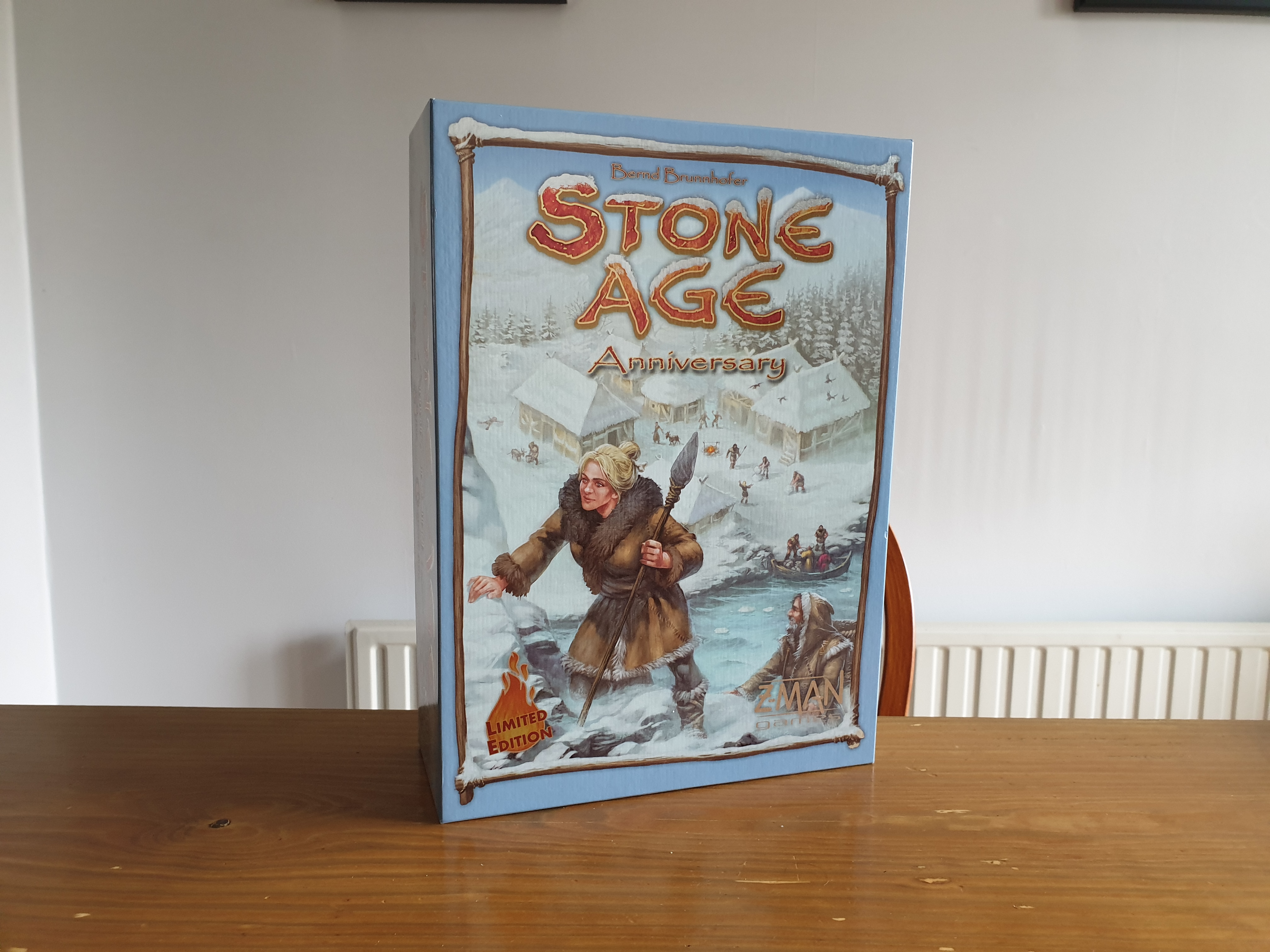Stone Age: Anniversary Edition has just been released by publisher Hans im Glück, 10 years on since its original outing. Designed by Bernd Brunnhofer, with art from Michael Menzel, the game sees 2 – 4 players spend around an hour living in prehistoric times. The game mixes dice rolling, set collection and worker placement mechanics to create a unique experience. Needing everything from food to gold, buildings will be constructed and the tribal population will grow. However, is the basic gameplay enjoyable enough to warrant being played in summer and winter? Let’s find out!
At the offset of the game the double sided main board is placed either side up. The resource and tool tokens are placed/piled in their associated regions on the board – though if you want to see all of the artwork they can be placed to one side. Building tiles are shuffled and stacks of 7 tiles, the amount of stacks equal to the player count, are added to the board. The civilization cards are shuffled, with the first four flipped and added to the board. Each player takes a player board plus a colour set of worker meeples: placing 5 workers on their board, 1 on the agriculture track, 1 on the score track.
The game is played in rounds of three phases: placement, actions and feeding. Starting with the first player, each player chooses an available location on the board. Unlike many worker placement games, when sending a worker to a location if it has room for more than one meeple the player can decide to send multiple there on one turn. Action are also not instantly taken, with all meeples placed by all players before actions are taken.
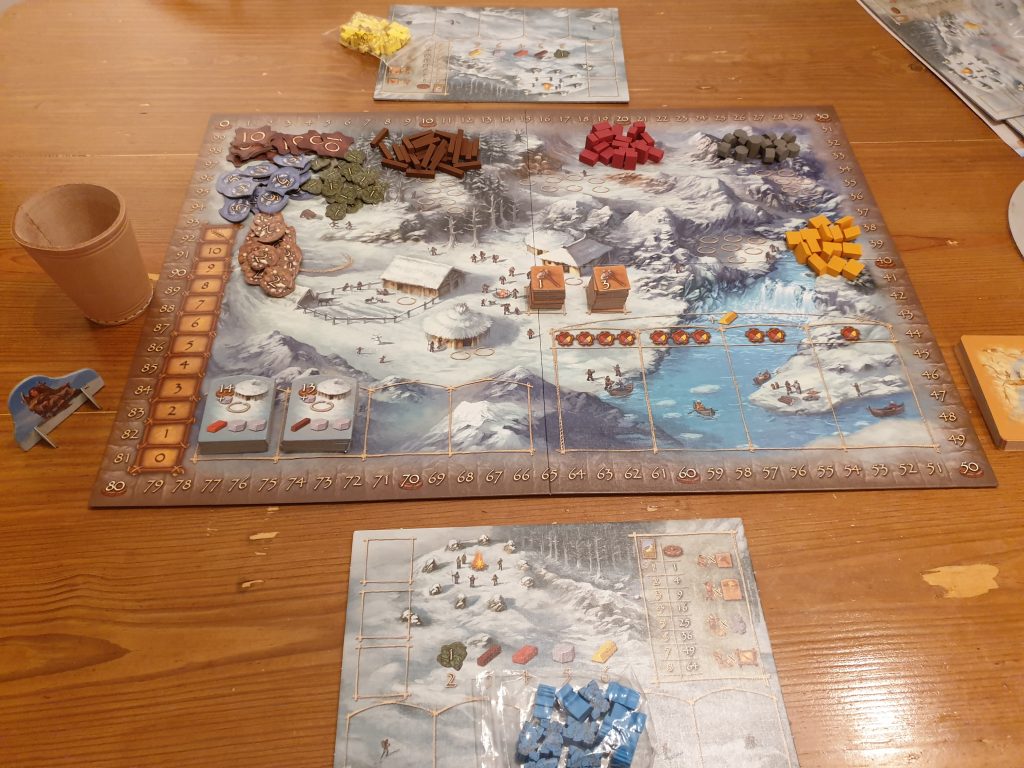
Village, building and civilization spaces are only available to one player each round, no matter the player count. The farm space will increase the players agriculture one space, whilst a tool is earnt for going to the tool maker. To go to the hut the player must send 2 meeples, though will gain an extra meeple – up to a total of 10 workers – for the next round.
Buildings have resource requirements on them that the player must spend to gain them, moving the tile onto their player board. These instantly score points, with some being specific points – denoted on the card – while others depend on the resources spent. Civilization cards increase in cost from right to left of the store – though cards slide down to the cheaper end between rounds if others are purchased. They cost any resource type, other than food, and give both instant bonuses and points for end game scoring.
Players will need resources of food, wood, clay, stone and gold throughout Stone Age. They mostly all work and are earnt the same way. At the end of the round players roll a number of dice equal to the number of workers they’ve sent to a location. Players can than increase the dice values via tools, before dividing the dice value total by the resource value. For example, rolling 7 for wood, which is valued at 3, would give 2 wood (7/3 rounded down), while spending two tools of value 1 would make the dice value 9 and see 3 wood earnt (9/3). Going on a hunt for food is slightly different from the rest, as there are unlimited spaces thus no chance for blocking. The others have a limit of 8 workers and depending on the player count only so many players can go to a location per round.
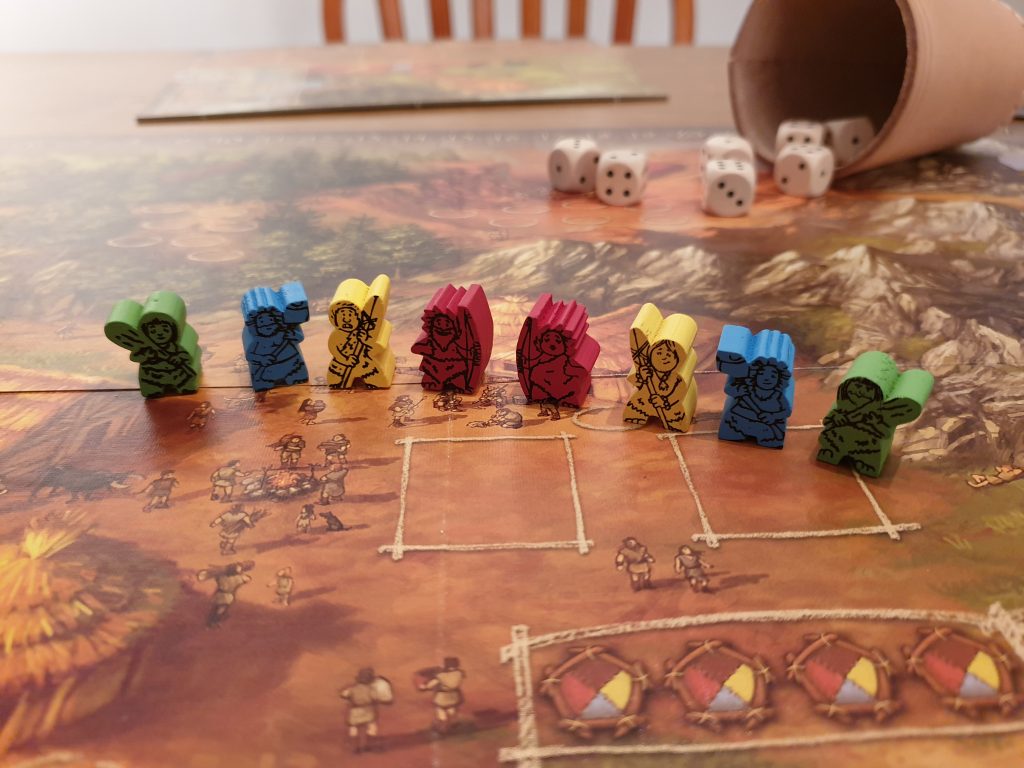
So, you’ve gained some points by building a building, rolled for some resources and even got an extra meeple for the next round. Before the next round starts those meeple need to be fed. Players will need to spend 1 food per worker they have minus the agriculture level they are on. Failing to have enough food will see player discarding a resource of any type in order to cover the costs. Run out of food and resources and regardless of the amount of starving workers you will lose 10 points.
The game continues with new rounds, with the starting player moving on clockwise, until either one of the building stacks or the civilization deck is depleted. When this occurs the current round is the last, before end game scoring. While a lot of points, from buildings, are scored in game the civilization cards are all scored once the game is finished. There are two types: grass backgrounds, which score based on unique sets, and sand background cards, which score based on conditions. Conditions such as, the number of workers in your tribe or your agriculture level. After all this, with scores sometimes reaching over 200, whomever has the highest score wins.
Stone Age 10th Anniversary Edition isn’t just made of aesthetic changes, a brand new winter themed mini expansion made the cut. Four Igloos join the plethora of buildings, sitting alongside the regular buildings not replacing them. They don’t drastically change the experience in any way. Even being classed as a mini expansion, over micro, is a stretch – they could easily be passed off as promotional tiles. The Wild Animals “mini” expansion of four cards is also included, again not changing much but adding variety like the Igloos. A Winter is Hard variant is also included in the rulebook, giving players the option to discard additional resources for buildings and civilization cards for bonus points. This is the biggest tweak from the new content and is something to try with those whom have played a few standard games.
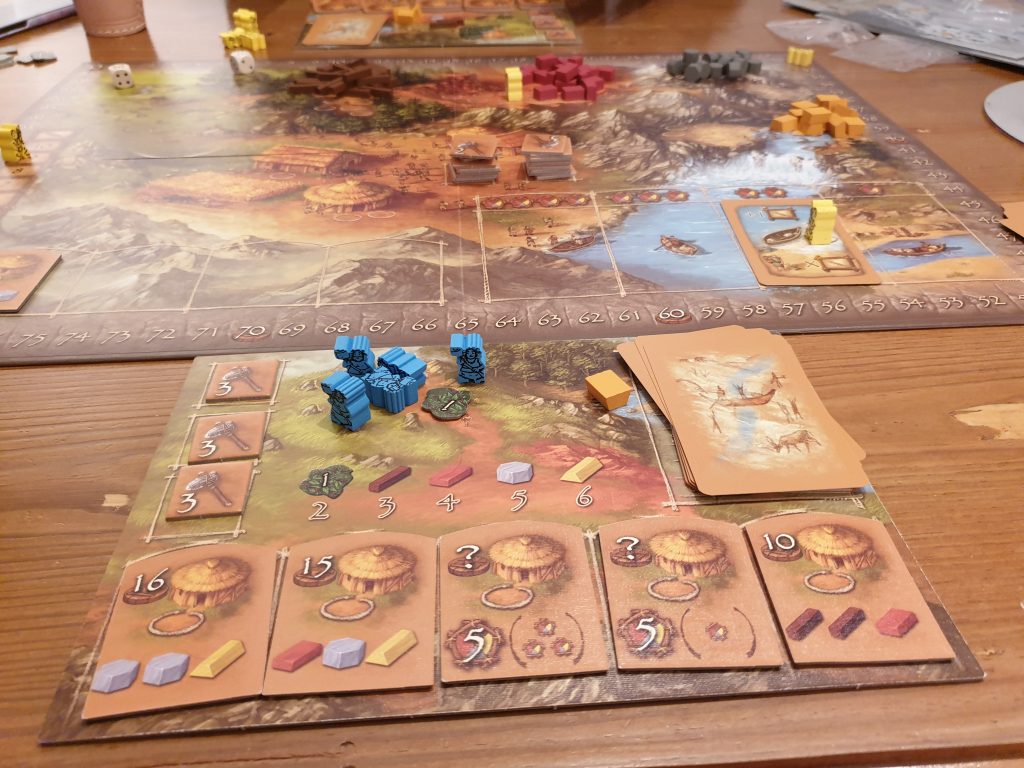
Dice rolling in a worker placement was something that made me hesitant to try Stone Age. Despite the obvious injection of luck there is plenty players can do to impact outcomes. With the amount of dice matching the meeples sent to a location players can increase their odds by sending more. The other side of the dice roll, players can then use their tools to alter the value of the dice.
Without this last part at best Stone Age would be too long a game to leave to chance. With it however allows for the fun and thrills of rolling dice to open up different strategies with a push your luck vibe. For gamers new to the genre this is ideal. They get the fun of dice rolling but quickly get to grips with concepts of placing workers on spaces to do actions.
Feeding your workers is a sometimes a contentious subject, though to my surprise it works in Stone Age. Again, it is an aspect of push your luck due to the dice rolling, but there are side strategies available. Players can gain additional workers and hope they’ll roll well to get the required food from a hunt or invest in agriculture enough to never worry about hunting altogether. The 10 points lost may sound large. Yet, in a game where scores of 200+ are possible it is enough of a deterrent without ruling a player out of winning. On top of this, it steers away from the annoyance losing obtained workers would create.
One aspect which lets the general design down is the arbitrary limitations imposed on the map that change depending on the player count. What this means is that someone often playing a two player game going into a three or four player game will have to remember the nuances. Other worker placement games do things similar; Viticulture has plenty of spaces made unavailable in a two player game. The difference is that in Stone Age there is no iconography there as a reminder. Going from a higher to lower player count ends up with new players forgetting the ruling completely, as it doesn’t make sense thematically, nor does it come with even a hint not to do it.
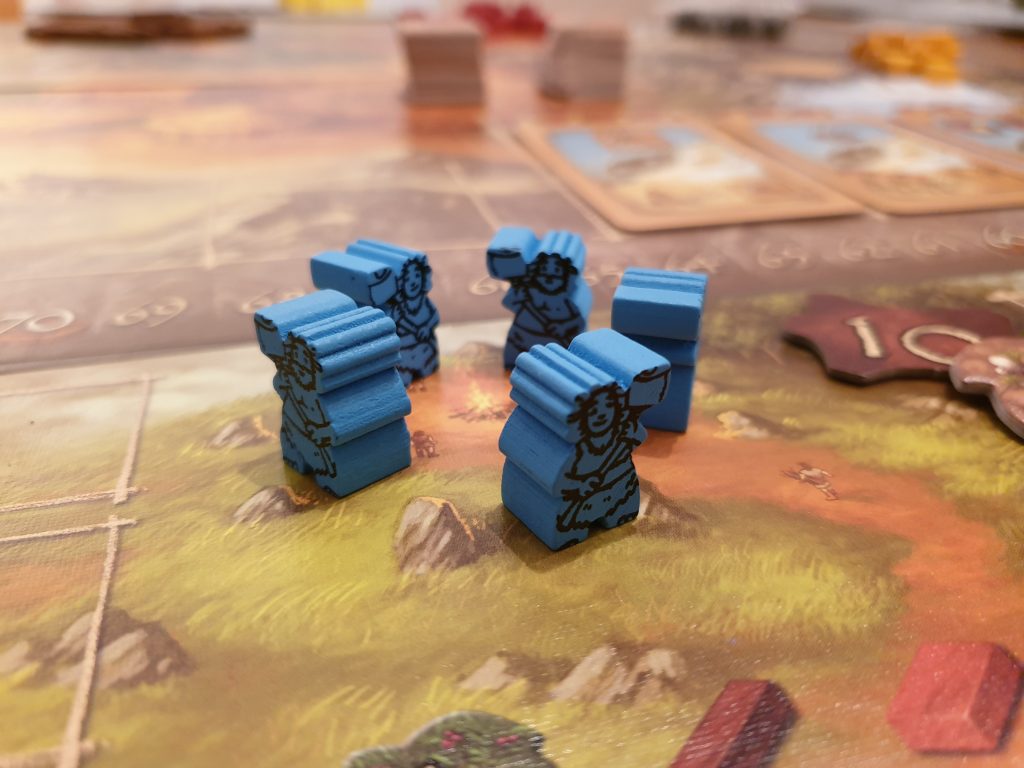
The anniversary edition comes with a double sided main board, double sided player boards and even double sided building tiles. One side features the glorious artwork of the original, exuding the warmth of summer with incredible details including a lot of tribe members roaming around. Flip the components over and the new winter side is unveiled in chilling brilliance. It isn’t just the overall look that is impressive. The little flair details make it stand out, such as a snowman or the snowball fight going on.
The meeples for each player colour are not only different silhouette shapes. There are also male and female tribe members – so each coloured tribe has two meeple designs. It’s a really nice touch to have details on the meeples, especially as they aren’t stickers left for players to put on after unboxing. The dice are decent, being standard D6 pipped dice, but the leather cup to roll them makes up for their averageness. The only aspects which slightly lets the “anniversary” quality level down is that the cards and tools are basically always Summer themed. This makes them pop in a negative way from the winter side of the boards. It is a small niggle but they simply don’t match the winter theme – which is a big selling point of this edition.
In a time filled with cult of the new Stone Age Anniversary Edition somewhat bridges both camps. The design holds up from ten years ago but the game has had a new lick of paint – and regardless of which side of the board you play on both offer stunning artwork. I was concerned dice could tarnish the worker placement experience. Thankfully, as there is plenty of mitigation methods they simple add some fun into the mix. The inclusion of dice also makes the title more friendly for players new to the genre – as the seriousness isn’t quite there. For this reason, Stone Age will be my go to game for introducing the worker placement genre to new players from now on.
[Editor’s Note: Stone Age: Anniversary Edition was provided to us by Asmodee for review purposes. The game is currently available on 365 Games for £64.49. It is also available from local UK board game stores, find your local store here]

